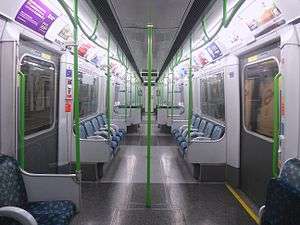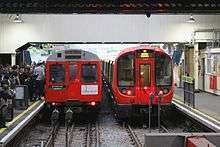London Underground D78 Stock
| D78 Stock | |
|---|---|
 7032 & 7007 on the last day of D stock operation. The additions on the front were specially added for this event - the one on the left is an old route indicator from the days before the D Stock, and the one on the right is a special design for the last day of the D Stock. | |
 The interior of a District line D78 Stock | |
| In service | 28 January 1980 – 21 April 2017 |
| Manufacturer | Metro-Cammell |
| Built at | Birmingham, England |
| Replaced |
O and P Stock R Stock |
| Constructed | 1978 - 1981 |
| Refurbishment |
Bombardier Transportation, Derby Litchurch Lane Works 2004 - 2008 |
| Number built | 75 sets (450 cars) |
| Formation | 6 cars per trainset |
| Capacity | 821 per trainset |
| Line(s) served | District |
| Specifications | |
| Car length |
DM 18.37 m (60 ft 3 in) UNDM/T 18.12 m (59 ft 5 in) |
| Width | 2.85 m (9 ft 4 in) |
| Height | 3.62 m (11 ft 11 in) |
| Weight |
DM 27.46 tonnes (27.03 long tons; 30.27 short tons) UNDM 26.11 tonnes (25.70 long tons; 28.78 short tons) T 18.40 tonnes (18.11 long tons; 20.28 short tons) |
| Traction system |
Pneumatic driven camshaft (GEC Traction) |
| Traction motors |
LT118 DC motor (Brush Traction) |
| Seating | 280 per trainset |
| Stock type | Subsurface |
| Notes | |
|
| |
The London Underground D78 Stock was a type of sub-surface rolling stock which operated on the District line of the London Underground, except on the Wimbledon to Edgware Road service. Following the withdrawal of the C Stock in June 2014, these were the oldest subsurface trains in service on the London Underground. The first units were withdrawn in January 2015 with the last withdrawn on 21 April 2017.
History
The D stock was ordered in 1976 to replace the pre-war CO/CP Stock and post-war R Stock on the District line.[1] Seventy-five six-car trains were built by Metro-Cammell, Birmingham, the first entering service on 28 January 1980 with final delivered in 1983.[2]
Details

The D Stock consisted of six-car trains, as opposed to the seven-car trains of CO/CP and R Stock, whose cars were shorter: under normal operation, each train consisted of two 3-car units, and 20 of the units are double-ended to allow 3-car operations under exceptional circumstances.[3]
The traction motors were the same LT118 type as on 1973 Tube Stock, but the bogies are different. With single-leaf doors and transverse and longitude seating, the style is very similar to 1983 stock on the Jubilee line. The D stock and 1983 stock trains were the only trains on the underground to have their headlights positioned under the train body; many trains on the underground had only their tail lights under the body.
The trains brought many innovations. The rubber coil suspension meant a smoother ride for passengers. The driver's cab is more ergonomic, the seat swiveling to move forwards, backwards, up or down. The dead man's handle is replaced by a joystick that needs to be twisted for the dead man feature, and moved fore and aft for motoring and braking. There is a Train Management System replacing the original Train Equipment Panel that highlights faults to the driver.
The most noticeable difference between the stock and earlier trains is that the doors are single leaf. Originally, passengers pressed door-control buttons to open them. Posters explaining how to operate the doors were put up around Tube stations in English, French and German when the stock was introduced. The stock had a "POGO" switch (Passenger open/Guard's open) that could switch control of the doors from passengers to the guard (when the stock was introduced, the guard controlled the doors from the rear cab).
While this function proved useful at above-ground stations and termini (especially in winter), station dwell time was significantly increased, and passengers had trouble getting used to the new system, not knowing how to open the door. By the late 1990s, the control of the doors went to the driver, but the buttons remained until they were removed on refurbishment between 2004 and 2008.
At over 18 metres (59 ft), the cars were the longest on the Underground. The windows had to be modified because of overheating when new, with pull-down opening windows installed in each car.
Usage
The stock was used on the District line, except the High Street Kensington to Edgware Road section, because the platforms are not long enough.
Between April 1985 and May 1987, the stock operated the East London line service in three-car formations, there being enough stock spare because of reduced services on the District line. This allowed A60/62 Stock to be sent for One Person Operation (OPO) conversion. The A60/62 stock took over the service again in 1987.
The stock started being replaced by S Stock in 2016.[4] It was replaced about 15 years short of its intended lifespan, as a consistent new fleet will allow for frequencies to be increased and will reduce maintenance costs.
In July 2011, Harrogate Chamber of Commerce proposed to use the stock on the Harrogate line from York to Leeds via Harrogate to increase capacity.[5] Stations in the Harrogate and Leeds urban areas are close together; the superior acceleration of the stock over the Class 150 diesel multiple units currently used is intended to cut journey times. It was proposed, the line would be electrified with third rail similar to the Docklands Light Railway, as opposed to the London Underground or the Southern region network.
On 24 July 2012, car 7007 was designated as the Olympic 2012 Train with London Underground Chief Operating Officer Howard Collins carrying the Olympic Torch from Wimbledon to Wimbledon Park.[6] This is the only London Underground train to be an Olympic Torch train.
Roster
| Formation | Upminster (D) → |
Notes | ||||||
|---|---|---|---|---|---|---|---|---|
| 7xxx (DM) |
17xxx (T) |
8xxx (UNDM) |
8xxx (UNDM) |
17xxx (T) |
7xxx (DM) | |||
| Facilities | ||||||||
| Numbers | 7000 ∥ 7128 |
17000 ∥ 17128 |
8000 ∥ 8128 |
8001 ∥ 8129 |
17001 ∥ 17129 |
7001 ∥ 7129 |
| |
| Formation | ← (A) (D) → | ||
|---|---|---|---|
| 75xx (DM) |
175xx (T) |
75xx (DM) | |
| Facilities | |||
| Numbers | 7500 ∥ 7538 |
17500 ∥ 17538 |
7501 ∥ 7539 |

- DM - Driving Motor car
- T - Trailer (non-powered) car
- UNDM - Uncoupling Non-Driving Motor car
De-icing equipment was fitted to trailers 17000 to 17048 (evens).
Refurbishment



The mid-life refurbishment was the first to be carried out under the PPP, by Metronet, and was delayed until contract negotiations were completed. A prototype unit of three cars (7008/17008/8008) was prepared by London Underground's Train Modification Unit at Acton Depot in 2001.[7][8] This had some detail differences from the eventual refurbishment, and was later brought up to the standard of the rest of the stock. The refurbishment programme began in summer 2005 with the work undertaken by Bombardier Transportation's, Derby Litchurch Lane Works.[9][10] The programme was completed in 2008.[11]
The refurbishment consisted of:
- applying London Underground livery with anti-vandal paint and window film
- restyling the interiors in green and white
- replacing maple flooring with rubber
- adding end-of-car windows
- replacing hanging straps (bobbles on springs) with grab bars
- covering the door buttons
- adding dot matrix indicators showing the station and destination on the inside and exterior front and sides
- adding an audio passenger information system guided by GPS and odometer, voiced by Emma Clarke: announcements for each station name include connecting lines, and provide warnings to "mind the gap between the train and the platform"
- adding two tip-up seats/disabled multi purpose area
- fitting air conditioning to driver's cab
- fitting CCTV
The refurbished D Stock were the first Underground trains to have electronic dot-matrix information displays on the sides of the cars; some pre-war trains had slot-in or reversible destination or non-stopping plates.
Withdrawal


Withdrawals commenced on 19 January 2015 when the first full 6-car train, formed of units 7510 and 7058, was withdrawn from service at Ealing Common Depot and loaded onto trucks for Long Marston for the driving motors to be converted into 230s and the other cars to be either scrapped or stored for future use. The last train, formed of units 7007 and 7032, ran on 21 April 2017.[12]
A farewell heritage tour took place on 7 May 2017 operated by units 7007+7032.[13]
In February 2016, four redundant D78 cars were used by the emergency services in a mock tube accident staged at Littlebrook Power Station.[14]
Heavy-rail diesel-electric conversion

In 2014, Vivarail purchased 156 Driving Motor cars and 70 trailing vehicles for conversion to diesel-electric multiple units.[15] It is proposed to run 75 units of two or three cars per unit.[16][17] They will become known as class 230 under TOPS.[18]
A prototype was produced for testing and accreditation in August 2015, with introduction to service in 2016.[19] The first Class 230 service to carry passengers operate on 19 July 2017 when a unit is used to operate a shuttle service from Honeybourne to the Rail Live exhibition at the Quinton Rail Technology Centre.[20]
The first customer for production Class 230 units was West Midlands Trains, which ordered three 2-car DMUs in October 2017. Subsequently, Transport for Wales ordered a total of five 3-car sets, to be built as BMMUs, in June 2018.[21][22]
References
- ↑ "District line replacement cars authorised" Railway Gazette International August 1976 page 285
- ↑ "Rolling Stock Data Sheet, London Underground (First Edition)" (PDF). WhatDoTheyKnow. Retrieved 17 April 2016.
- ↑ Connor 2015, p. 142
- ↑ "Transforming the Tube" (PDF). Transport for London. July 2008. Archived from the original (PDF) on 5 June 2011. Retrieved 28 May 2009.
- ↑ "HARROGATE LINE NEWS 1 1st Meeting supports bid" (PDF). Harrogate Chamber of Commerce. 12 August 2011. Archived from the original (PDF) on 1 October 2011. Retrieved 26 August 2011.
- ↑ "Olympic torch: Flame rides on London Underground train". BBC News Online. 24 July 2012. Retrieved 24 August 2012.
- ↑ "Spellar inspects District Line stock" Rail Magazine issue 436 29 May 2002 page 16
- ↑ D78 modernised Railway Gazette International 1 October 2002
- ↑ "Metronet tests refreshed D stock" Rail Magazine issue 515 8 June 2005 page 26
- ↑ D78 stock gets a fresh new look Railway Gazette International 1 August 2005
- ↑ "D78 stock refurbishment complete" Today's Railways issue 78 June 2008 page 19
- ↑ Farewell to the D stock The Railway Magazine 3 May 2017
- ↑ https://www.ltmuseum.co.uk/whats-on/events-calendar/heritage-vehicles-outings#
- ↑ "Emergency Services Stage Mock Tube Disaster" Rail Express issue 239 April 2016 page 9
- ↑ "Viva Vivarail's D-train transformation" Rail Magazine issue 771 1 April 2015 page 60
- ↑ D78 Stock Conversion is Go Archived 16 July 2015 at the Wayback Machine. Modern Railways December 2014 pages 37-38
- ↑ "Vivarail Homepage". Vivarail. Retrieved 20 January 2015.
- ↑ Sam McCaffrey (2015-05-01). "'They don't make trains like this anymore'". Rail Technology Magazine. Retrieved 2015-05-17.
- ↑ The Engineer http://www.theengineer.co.uk/blog/d-railed-old-tube-trains-gain-a-new-lease-of-life/1020946.article
- ↑ "D-Train to carry passengers" Rail Magazine issue 824 13 April 2017
- ↑ "Vivarail to supply three D-Trains to West Midlands Trains". www.railtechnologymagazine.com. Retrieved 2018-06-05.
- ↑ "KeolisAmey reveal new-look Wales trains and services". 4 June 2018. Retrieved 8 June 2018.
Sources
External links
| Wikimedia Commons has media related to London Underground D78 Stock. |